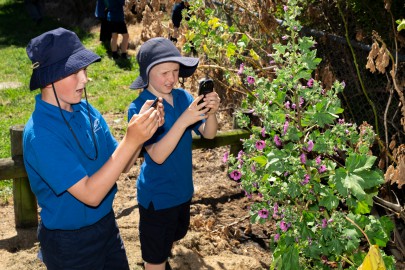Heathcote Valley School, Canterbury
In this section
-
Participating schools
- Curious Minds visit Lincoln
- Franz Josef & Fox Glacier Schools
- Greymouth High School
- Haast School
- Halswell Domain
- Halswell School
- Heathcote Valley School
- Kaniere School
- Kaniere visit Lincoln
- Hokitika Primary
- Leeston Consolidated School
- Manuka Primary School
- Mission Heights
- Mt Albert Grammar
- Paroa School
- Rudolf Steiner School
- Takapuna Grammar
- TKKM
- Wakaaranga Primary School
- Whataroa School

Heathcote Valley School students (Kauri Team) recording tree mallow in the domain. Image: Brad White
is a small Decile 8 school with a strong environmental focus which provided a great fit for our education programme on weeds. They have been involved in several initiatives including restoring Birdsey Reserve (opposite the school) and restoration replanting of Port Hills saddle (with Kaniere and Lyttelton schools) following the fires of 2017. The school is located near the Avon Heathcote Estuary and the lower reaches of Heathcote River, which are hot-spots for spartina, an invasive maritime grass and one of our priority species for 2018.
Our first visit was with the Kauri Team (Y5–6, 18 students), hosted by teacher Anna Murdoch. Bradley White joined us for the afternoon to photograph our time together.
Our second visit was with the Kahikatea Team (Y7–8, 15 students), hosted by Liz Haddock. Matt Stanford (Enviroschools Canterbury Facilitator) has worked closely with Heathcote Valley School and joined us for part of the day to help out.
We followed our usual pattern of delivery. In the morning Robinne began with puzzles and activities teaching about what weeds are and how they disperse. Murray then taught about identifying and recording weeds using smartphone apps and other resources.
Hugh Gourlay, our biocontrol expert, joined us in the afternoons of each visit to talk about biocontrol and to let the students handle and study some biocontrol insects – this is always very popular with students. Hugh brought with him tradescantia leaf beetles (‘Shiny’; Neolema ogloblini) and green thistle beetles (Cassida rubiginosa).
We then all went on afternoon field trips to the nearby Heathcote Domain on a ‘treasure hunt’ to find and record local weeds.
What were some of the plants that we found?
In the Heathcote Domain, we found a range of weed species for the students to record using the iNaturalist NZ app.
We found periwinkle (Vinca major) in abundance, in the domain alongside the railway (and dominating embankments to the north-west beside the tracks). It’s well known that railway land can provide disturbed habitat and a conduit for weeds. Within the domain, we also found Vinca major ‘Variegata’ planted in a garden bed, demonstrating how variegated cultivated forms can potentially revert to become more vigorous and then potentially jump-the-garden-fence.
Two widespread and well-known weeds of the Fabaceae (pea) family, broom (Cytisus scoparius) and gorse (Ulex europaeus), showed evidence of local control – the small amount of gorse found had been sprayed, and some broom had obvious galls from the biocontrol broom gall mite. The less widespread but locally common French broom (Genista monspessulana), with distinctive trifoliate leaves, was found nearby, alongside the school grounds. Another local weed belonging to the Fabaceae was broad-leaved sweet pea (Lathyrus latifolius).
Other Environmental Weeds commonly found in Heathcote Domain included:
- African boxthorn (Lycium ferocissimum)
- capeweed (Arctotheca calendula)
- ivy (Hedera helix)
- large bindweed (Calystegia silvatica)
- pampas grass (Cortaderia selloana)
- sycamore (Acer pseudoplatanus)
- tree mallow (Malva arborea).
Further afield, Murray found native ngaio (Myoporum laetum) planted on Station Road, and Australian boobialla (Myoporum insulare) planted on Port Hills Road, several km’s away. We brought some specimens of each into the classroom to discuss. Murray explained that these coast-loving plants are very similar, and that the Australian species has been mistaken for our native relative. This mix-up has unfortunately happened in restoration plantings, where the Australian weed has been accidentally planted instead of the New Zealand native. We discussed that boobialla can hybridise and displace our native relative, causing “genetic contamination.” The students looked closely to examine the differences between species – ngaio has purplish-brown new leaf buds (compared to green in boobialla), more obvious leaf pitting (spots), and larger flowers.
In total, more than 120 observations were made of more than 50 species.









![Heathcote Valley School students (Kauri Team) recording cleavers ([Galium aparine]) in the domain. Image: Brad White Image](/assets/Education/Schools-Great-weeds-hunt/Heathcote_Valley_School_students_recording_cleavers_White__FillMaxWzE1LDE1XQ.jpg)






























